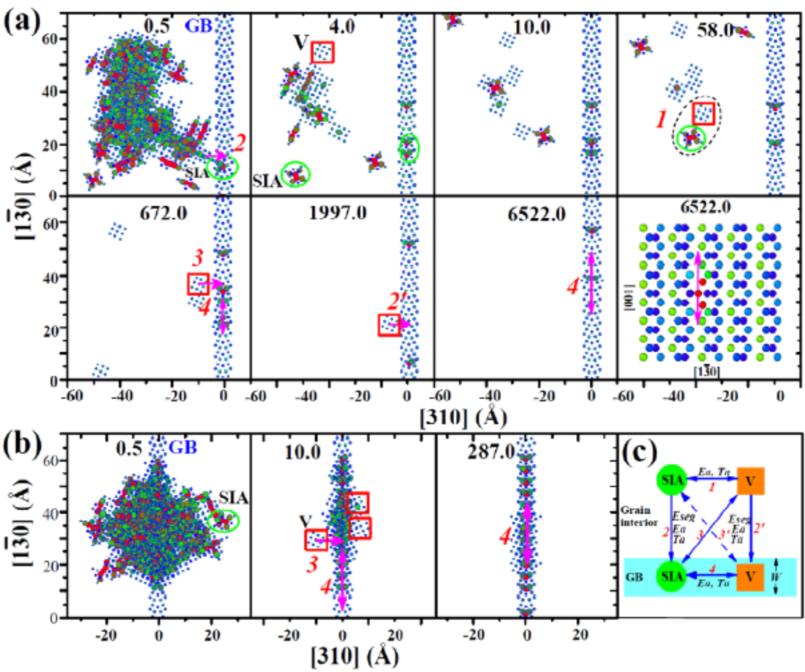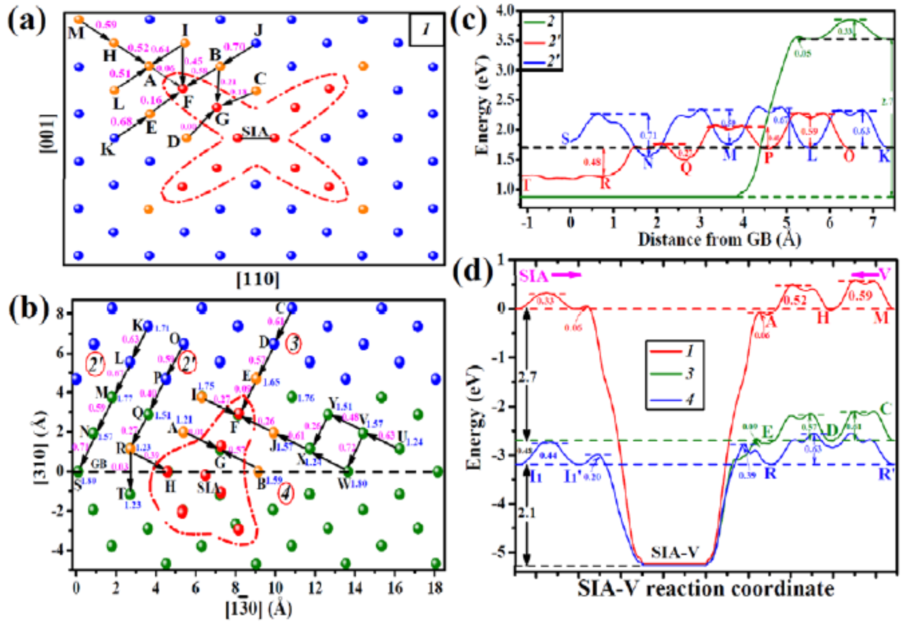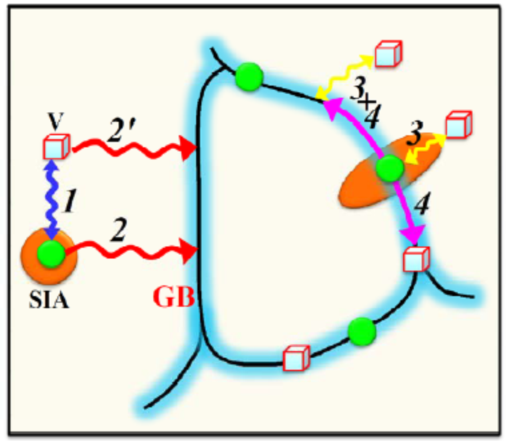In recent years, nano-crystalline metals (NCs) with the average grain size of about 100 nm are found to exhibit radiation tolerance experimentally. A recent study reported that the self-healing ability of NCs is attributed to emission of the self-interstitial atoms from the grain boundaries (GBs) and thus recombination with vacancies near the GBs. However, this mechanism cannot be readily understood, since self-interstitial atoms are often tightly bound to the GB due to a large binding energy with the GB and difficult to be emitted from the GB. Alternative approaches remain to be explored to uncover the origin of radiation-tolerance of NCs.
Given this, collaborating with researchers in University of Science and Technology of China, Institute of Plasma Physics, Hefei Institutes of Physical Science, Beihang University and Institute of Modern Physics, Chinese Academy of Sciences, a nuclear material study team led by LIU Changsong and FANG Qianfeng in Institute of Solid State Physics, Hefei Institutes of Physical Science revisited the radiation-tolerance of nano-crystalline iron by using a set of self-developed sequential multi-scale simulation programs which are composed of molecular dynamics simulations, molecular statics calculations and the object kinetic Monte Carlo method embedded with energy barrier determination methods, for example, the dimer method and the nudged elastic band method. Other relevant codes for visualizing defects evolution and identifying defects are also developed.
Researchers found that the self-healing capability of nano-crystalline iron was found to be closely related to the coupling of the individual fundamental segregation and annihilation processes of vacancies and interstitials near the GB (Fig. 1). Statically, both near the GB and at the GB, a low-energy-barrier/barrier-free region forms around the interstitial which promotes the annihilation of vacancies (Fig. 2). Before segregating into the GB, the interstitial annihilates lots of vacancies near the GB as it diffuses near the GB together with the low-barrier region.
In addition, although the interstitial is tightly bound to the GB after segregation, it efficiently removes the vacancies near the GB while moving along the GB, with the low-barrier region extending into the neighborhood of the GB and even into the grain interior. These two mechanisms were found to work at low temperatures, even temperatures where the vacancy was immobile. This study revealed the interaction of the major radiation defects at different scales and thereby uncovered the origin of the high radiation resistance of nano-crystalline iron (Fig. 3).
This study was published in Acta Materialia with title Radiation resistance of nano-crystalline iron: Coupling of the fundamental segregation process and the annihilation of interstitials and vacancies near the grain boundaries. And the supplementary material was published on Data in Brief with title Energetic and kinetic dataset on interaction of the vacancy and self-interstitial atom with the grain boundary in -iron.
This work was supported by the National Magnetic Confinement Fusion Program, the Strategic Priority Research Program of the Chinese Academy of Sciences, the National Natural Science Foundation of China, the Scientific Research Grant of Hefei Science Center of CAS Research Program, and by the Center for Computation Science, Hefei Institutes of Physical Sciences. This research project was part of the CRP (Co-ordinated Research Projects) program carried out under the sponsorship of the International Atomic Energy Agency (IAEA).

Fig. 1. (a-b) Representative simulation snapshots illustrating the progression of a collision cascade near a Σ5 (310)/[001] symmetric tilt GB at 1000 K and (c) fundamental atomic processes of the vacancy and interstitial evolution near the GB . (Image by LI Xiangyan)

Fig. 2. (a-c) Energetic and kinetic interaction of the SIA-V pair in the bulk and near the GB at 0 K and (d) possible annihilation paths for the vacancy-interstitial pairs near the GB. (Image by LI Xiangyan)

Fig. 3. Schematic illustration of the complete self-healing process in nano-crystalline iron. Here, the numbers denote the same atomic processes as in Fig. 1. The orange sphere and ellipsoid around the green sphere represent the low-barrier annihilation region around an SIA in the bulk and at the GB, respectively, as revealed by the results of the molecular statics calculations shown in Fig. 2(a) and (b). (Image by LI Xiangyan)
Contact:
XU Yichun, LIU Changsong
Key Laboratory of Materials Physics, Institute of Solid State Physics, Hefei Institutes of Physical Science
Hefei, Anhui 230031,China.
Tel: +86-551-65591062
E-mail: xuyichun@issp.ac.cn and csliu@issp.ac.cn (C.S. LIU)
 Tel: +86-551-65591206
Tel: +86-551-65591206
 Fax: +86-551-65591270
Fax: +86-551-65591270
 Emai: zhous@hfcas.ac.cn
Emai: zhous@hfcas.ac.cn
 350 Shushanhu Road
350 Shushanhu Road